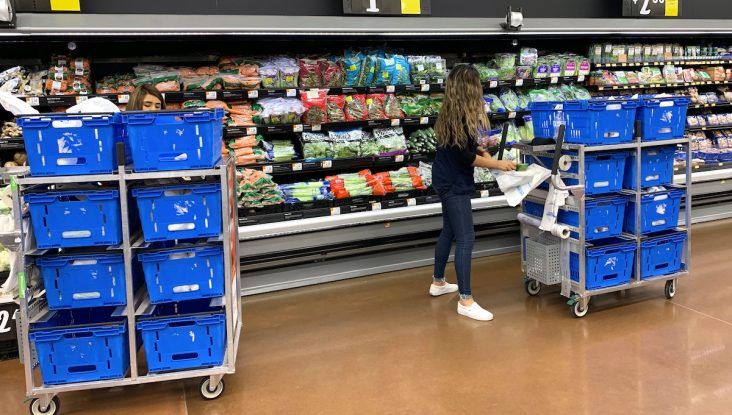Online grocery sales fall 6% in March
by April 11, 2022 2:49 pm 1,626 views

Consumers spent $8.7 billion for online groceries in March, down 6% from a record $9.3 billion in the year-ago period, according to the Brick Meets Clicks/Mercatus Grocery Shopping Survey. Consumers are also opting for delivery over pickup.
First quarter 2022 online grocery sales totaled $17.4 billion, 2.5% lower than the comparable quarter of 2021.
The Mercatus data indicates a shift in grocery shopping behaviors as more consumers have become vaccinated for COVID-19. Ship-to-home groceries from retailers like Amazon saw a 30% decline to $1.4 billion in March. Mercatus said the decline was from a 13% reduction in the number of orders placed by active users and a 23% drop in average order values. The orders can include auto ship products like dog food or bottled water.
Despite the soaring increase of grocery pickup amid the pandemic, pickup sales fell 11% in March. Online grocery sales for pickup totaled $3.8 billion, compared to $4.3 billion in March of 2021. Mercatus found order frequency for pickup fell 8%, while average online ticket values dipped about 4% compared to the year-ago period.
Consumers are also more comfortable with grocery order deliveries, which rose 20% in March compared with March 2021. Online grocery orders for delivery totaled $3.5 billion March, up from $2.9 billion a year ago. This shopper group placed 13% more orders and the average value of the orders were up 7% compared to a year ago, Mercatus reported.
David Bishop, partner at Bricks Meets Click, noted two factors behind rising grocery deliveries. He said the aggressive expansion of third-party providers into grocery is enabling additional ways for people to shop online. Secondly, he said newer services create faster cycle times which is more appealing to consumers.
Mercatus also said 4% more shoppers are using traditional grocery and mass grocery stores like Walmart compared to a year-ago. This cross-shopping demographic is about 29% of the survey respondents.
Economists at Wells Fargo Securities have said consumers are becoming more cost-conscious with the soaring inflationary prices on everything from cereal to fresh chicken and toilet paper. Wells Fargo also expects consumers will shop more retailers to find options for the overall best value. A trade-down to lower-priced brands is also a possibility if prices remain elevated well into the second quarter.
“A key takeaway from March’s report is that online grocery sales have retained much of the gains from a year ago, proving the resilience of grocery eCommerce,” said Sylvain Perrier, Mercatus president and CEO. “Even so, conventional grocers need to develop and strengthen their first-party web and mobile channels, leverage third-party solutions to fill in the gaps, and excel at executing the services they offer.”
Online grocery sales ship-to-home sales was 17% of the first quarter total, down from 2% in the year-ago period. Pickup sales were unchanged at 46% of the total, and delivery accounted for 38%, up from a year ago.
